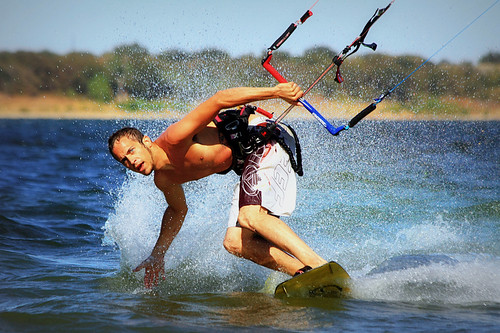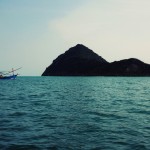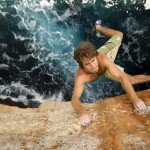
Kiteboarding or Kitesurfing is a surface water sport that uses the wind to pull a rider through the water on a small surfboard or a Kiteboard. Generally Kiteboarding refers to a style of riding known as freestyle or wake-style, whereas Kitesurfing is more “wave-riding” oriented. These two styles usually require different boards and specific performance kites.
A Kitesurfer or Kiteboarder uses a board with or without foot-straps or bindings, combined with the power of a large controllable kite to propel the rider and the board across the water. In 2006, the number of Kitesurfers has been estimated at around 150,000 to 210,000, with 114,465 inflatable kites sold that same year.
The sport is becoming safer due to innovations in kite design, safety release systems, and instructions. Riding styles have evolved to suit riders and conditions, such as Wakestyle, Waveriding, Freestyle, Freeride, Jumping, and Cruising.
Kitesurfing basics
Kiteboarding can pose hazards to kitesurfers, beachgoers, bystanders and others on the water. Many problems and dangers that may be encountered while learning kiting can be avoided or minimized by taking professional instruction through lesson centres.
Kitesurfing schools provide courses and lessons to teach skills including kite launching, flying, landing, usage of the bar, lines and safety devices.
Turning
A beginner can turn by stopping, sinking backwards into the water, then turning the kite in the opposite direction and starting again. A heel turn jibe is a quicker, more skillful turn that is executed by slowing down, flattening the board, then reversing the board flat on the water by bringing the rear foot around downwind to eventually become the new leading foot. The direction of the kite is then reversed, which swings the surfer’s path in a half circle, centered on the kite. As the turn ends, the kite is flown over to be in front of the surfer again.
A poorly executed turn will “fly” the surfer, and is often followed by a tumble if the surfer can’t put the board down at the right angle.
A careless turn in high winds can easily swing the rider into the air and result in an uncontrolled impact.
Controlled flying and jumping
Controlled flying is possible and one of the biggest attractions of the sport. Before jumping, the surfer builds up tension in the lines by strongly edging the board. Then the kite is flown quickly to an overhead position, sometimes just as the surfer goes over a wave. As the kite begins to lift, the board edge is then ‘released’ and the rider becomes airborne. The kite is then piloted from overhead to the direction of travel. A large variety of maneuvers and tricks can be performed while jumping.
Jumping can be very risky, riders must keep a clear buffer zone downwind when attempting to jump. Litigation has come about due to riders not exercising due care when jumping.

Board grabs
Board grabs are tricks performed while a rider is jumping or has gained air from popping by grabbing the board in a number of positions with either hand. Each grab has a different name dependent on which part of the board is grabbed and with which hand it is grabbed by. Rear hand grabs are known as Crail, Indy, Trindy, Tail, Tailfish, and Stalefish; while front hand grabs are known as Slob, Mute, Seatbelt, Melon, Lien, and Nose. Names generally originate from other board sports like skateboarding and snowboarding.
A number of grabs can also be combined into one trick. A rider may perform a tail grab going to indy by moving the rear hand from the back of the board to the middle of the toe side edge.
More Information about Kiteboarding in Pranburi; Kitesurfingpranburi, Kiteboarding Asia
Source: wikipedia.org

 Kitesurfing is the new buzz in extreme water sports
Kitesurfing is the new buzz in extreme water sports ท่องเที่ยวประจวบคีรีขันธ์
ท่องเที่ยวประจวบคีรีขันธ์ Hua Hin Honda Summer Festival
Hua Hin Honda Summer Festival Presentation Photos
Presentation Photos Learning the Complete History of Rock Climbing
Learning the Complete History of Rock Climbing

